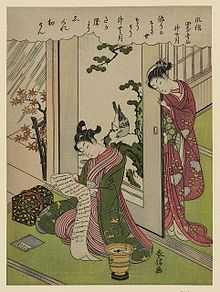Wakashū

Wakashū (Japanese:若衆, literally "young person", although never used for girls), is a historical Japanese term indicating an adolescent boy; more specifically, a boy between the ages at which his head was partially shaven (maegami) (about 5–10 years of age), at which point a boy exited early childhood and could begin formal education, apprenticeship, or employment outside the home, and the genpuku coming of age ceremony (mid teens through early 20s), which marked the transition to adulthood.[1][2] During this period, the wakashū wore a distinctive hairstyle, with a small shaved portion at the crown of the head and long forelocks at front and sides, and typically wore kimono with open sleeves (wakiake); boys from wealthier families could wear furisode. After the coming of age ceremony, the forelocks would be shaved off, giving the adult male hairstyle (chonmage), and the boy would assume the adult male style of kimono with rounded sleeves. Although any given person would be clearly classified as a child, wakashū or adult, the timing of both boundaries of the wakashū period were relatively flexible, giving families and patrons the ability to accommodate the development and circumstances of the individual boy.
The concept of wakashū contained several partially overlapping elements: an age category between childhood and adulthood; the social role of a pre-adult or adolescent boy, usually conceived of as a subordinate (student, apprentice or protégé); and the idea of the "beautiful youth", a suitable target for homosexual desire and the subject of wakashūdo, "the way of youths". As boys were considered eligible for homosexual liaisons only when they were wakashū, their patrons occasionally delayed their coming of age ceremony beyond socially acceptable limits, leading to legal efforts in 1685 to require all wakashū to undergo their coming of age ceremony by age 25.[3]

In the Meiji era, the term became obsolete; the first meanings were replaced by the new term shōnen, and the last by the related construction bishōnen ("beautiful boy").[4]
In kabuki theatre wakashū (or wakashū-gata) referred to actors specializing in adolescent male roles (and who were usually wakashū themselves).[5] Wakashū often also performed as onnagata ("woman-role"; female impersonators).
See also
References
- ↑ Pflugfelder, Gregory M. (1999). Cartographies of desire: male-male sexuality in Japanese discourse, 1600-1950. University of California Press. p. 33. ISBN 0-520-20909-5.
- ↑ Leupp, Gary P. (1997). Male Colors: The Construction of Homosexuality in Tokugawa Japan. University of California Press. p. 125. ISBN 0-520-20900-1.
- ↑ Leupp, Gary P. (1997). Male Colors: The Construction of Homosexuality in Tokugawa Japan. University of California Press. pp. 34, note 24. ISBN 0-520-20900-1.
- ↑ Pflugfelder, Gregory M. (1999). Cartographies of desire: male-male sexuality in Japanese discourse, 1600-1950. University of California Press. pp. 221–234. ISBN 0-520-20909-5.
- ↑ Leupp, Gary P. (1997). Male Colors: The Construction of Homosexuality in Tokugawa Japan. University of California Press. p. 90. ISBN 0-520-20900-1.